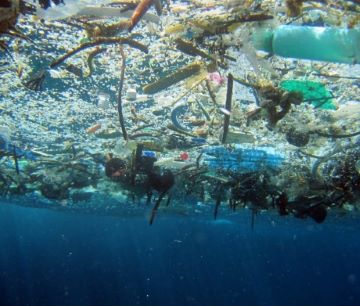690123_Garbage soup_360 px width.jpg

Debris from land often finds its way to the ocean. Sunlight breaks plastic down into small pieces, making a “soup” of garbage in the Great Pacific Garbage Patch. Credit: Marine Debris Program, NOAA
The Great Pacific Garbage Patch isn’t what you think. It’s often depicted as a big “island” of junk—plastic bottles, fishing nets, sneakers, tires, and other debris. But that’s not the case. In fact, you could sail right through it and never even notice. That’s because, instead of an island, it’s more of a “soup”—tiny bits of plastic and other debris spread across an area twice the size of Texas, from the surface to depths of hundreds of feet.
The Great Pacific Garbage Patch is actually two patches. One is off the coast of Japan; the other, between Hawaii and California. They’re held in place by currents that swirl around the North Pacific Ocean. Most of the debris comes from land. It takes years for a plastic bottle or other bit of junk to spiral into the garbage patch. During that time, sunlight breaks down plastic into smaller and smaller pieces. Eventually, they’re no more than dots. A 2016 study estimated the total at 1.8 trillion pieces of debris, adding up to about 90,000 tons. And the numbers have risen by a good amount since then.
Pieces of different sizes and weights settle at different depths. Some fall all the way to the bottom. But most stay within a few hundred feet of the surface.
The debris is scattered over such a wide area that it’s hard to track, even with satellites. But scientists are working on new techniques to keep an eye on it with a European satellite—tracking a “soup” of garbage that’s swirling around the North Pacific.

